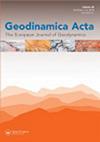Late Cretaceous eclogitic high-pressure relics in the Bitlis Massif
IF 1.5
Q1 Earth and Planetary Sciences
引用次数: 31
Abstract
A new occurrence of eclogites was found in the Kesandere valley in the eastern most part of the Bitlis complex, SE Anatolia. These high-pressure (HP) relics were preserved in calc-arenitic metasediments within the high-grade metamorphic basement of the Bitlis complex. The eclogitic parageneses were strongly overprinted during decompression and heating. These new eclogites locality complements the evidence of blueschist-facies metamorphism documented recently in the meta-sedimentary cover sequence of this part of the Bitlis complex. Thermodynamic calculations suggest peak conditions of ca. 480–540 °C/1.9–2.4 GPa. New U/Pb dates of 84.4 ± .9 and 82.4 ± .9 Ma were obtained on zircons from two Kesandere eclogite samples. On the basis of geochemical criteria, these dates are interpreted to represent zircon crystallization during the eclogitic peak stage. Kesandere eclogites differ from those previously described in the western Bitlis complex (Mt. Gablor locality) in terms of lithologic association, protolithic origin, and peak P–T conditions (600–650 °C/1.0–2.0 GPa, respectively). On the other hand, eclogitic metamorphism of Kesandere metasediments occurred shortly before blueschist-facies metamorphism of the sedimentary cover (79–74 Ma 40Ar/39Ar white mica). Therefore, the exhumation of Kesandere eclogites started between ca. 82 and 79 Ma, while the meta-sedimentary cover was being buried. During this short time span, Kesandere eclogite were likely uplifted from ~65 to 35 km depth, indicating a syn-subduction exhumation rate of ~4.3 mm/a. Subsequently, eclogite- and blueschist-facies rocks were likely retrogressed contemporarily during collision-type metamorphism (around 72–69 Ma). The Bitlis HP rocks thus sample a subduction zone that separated the Bitlis–Pütürge (Bistun?) block from the South-Armenian block, further north. To the south, Eocene metasediments of the Urse formation are imbricated below the Bitlis complex. They contain (post Eocene) blueschists, testifying separation from the Arabian plate and southward migration of the subduction zone. The HT overprint of Kesandere eclogites can be related to the asthenospheric flow provoked by subducting slab retreat or break off.比特里斯地块晚白垩世榴辉岩高压遗迹
在安纳托利亚东南部Bitlis杂岩东部大部分的Kesandere山谷中发现了一个新的榴辉岩产状。这些高压(HP)遗迹保存在比特里斯杂岩高变质基底内的钙砂质变质沉积层中。在减压和加热过程中,榴辉共生层强烈叠印。这些新的榴辉岩位置补充了最近在比特里斯杂岩的这部分变质沉积盖层序中记录的蓝片岩相变质作用的证据。热力学计算表明峰值条件约为480-540°C/ 1.9-2.4 GPa。两种榴辉岩锆石的U/Pb年龄分别为84.4±0.9 Ma和82.4±0.9 Ma。根据地球化学判据,这些日期代表了榴辉岩峰期的锆石结晶。Kesandere榴辉岩在岩性组合、原石器起源和峰值P-T条件(分别为600-650°C/ 1.0-2.0 GPa)方面与之前在Bitlis杂岩西部(Mt. Gablor地区)描述的榴辉岩不同。另一方面,在沉积盖层(79 ~ 74 Ma 40Ar/39Ar白云母)蓝片岩相变质作用发生之前不久,Kesandere沉积的榴辉岩变质作用就发生了。因此,Kesandere榴辉岩的发掘开始于约82 ~ 79 Ma之间,此时变质沉积盖层正在被掩埋。在这短时间内,Kesandere榴辉岩可能从~65 ~ 35 km深度隆升,表明同步俯冲掘出速率为~4.3 mm/a。其后,榴辉岩和蓝片岩相岩可能在碰撞变质期(72 ~ 69 Ma)发生了当代退变。因此,Bitlis HP岩石样本是一个将Bitlis - p ttrge (Bistun?)块体与更北的南亚美尼亚块体分开的俯冲带。在南面,乌尔斯组的始新世变质沉积层在比特里斯杂岩下叠瓦状。它们含有(始新世后)蓝片岩,证明了与阿拉伯板块的分离和俯冲带的向南迁移。Kesandere榴辉岩的高温叠印可能与俯冲板块后退或断裂引起的软流圈流动有关。
本文章由计算机程序翻译,如有差异,请以英文原文为准。
求助全文
约1分钟内获得全文
求助全文
来源期刊

Geodinamica Acta
地学-地球科学综合
CiteScore
4.50
自引率
0.00%
发文量
0
审稿时长
25 weeks
期刊介绍:
Geodinamica Acta provides an international and interdisciplinary forum for the publication of results of recent research dealing with both internal and external geodynamics. Its aims to promote discussion between the various disciplines that work on the dynamics of the lithosphere and hydrosphere. There are no constraints over themes, provided the main thrust of the paper relates to Earth''s internal and external geodynamics. The Journal encourages the submission of papers in all fields of earth sciences, such as biostratigraphy, geochemistry, geochronology and thermochronology, geohazards and their societal impacts, geomorphology, geophysics, glaciology, igneous and metamorphic petrology, magmatism, marine geology, metamorphism, mineral-deposits and energy resources, mineralogy, orogeny, palaeoclimatology, palaeoecology, paleoceanograpgy, palaeontology, petroleum geology, sedimentology, seismology and earthquakes, stratigraphy, structural geology, surface processes, tectonics (neoteoctonic, plate tectonics, seismo-tectonics, Active tectonics) and volcanism.
Geodinamica Acta publishes high quality, peer-reviewed original and timely scientific papers, comprehensive review articles on hot topics of current interest, rapid communications relating to a significant advance in the earth sciences with broad interest, and discussions of papers that have already appeared in recent issues of the journal. Book reviews are also included. Submitted papers must have international appeal and regional implications; they should present work that would be of interest to many different specialists. Geographic coverage is global and work on any part of the world is considered. The Journal also publishes thematic sets of papers on topical aspects of earth sciences or special issues of selected papers from conferences.
 求助内容:
求助内容: 应助结果提醒方式:
应助结果提醒方式:


